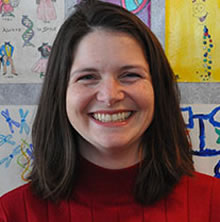
How do you explain to a child that he or she is battling a genetic condition? It's simple. You explain it simply.
Dawn Laney, a genetic counselor, research coordinator and instructor in Emory University's Department of Human Genetics, is also the author/co-author of three children's books. She wrote the books to explain the genetic conditions Fabry disease, Mucopolysaccharidoses (MPS), and Pompe Disease to children in a way that they can easily relate to.
As a genetic counselor, Laney works closely with patients affected by lysosomal storage diseases, primarily Fabry disease. After diagnosing patients, Laney has to explain the test results and potential treatment options to patients and their families.
Each of the body's cells has a lysosome, which serves as the "recycling center" of the cell. In turn, each of these lysosomes contains special enzymes. If the enzymes malfunction or glycolipids accumulate in the cells, the body begins to experience problems. While explaining this condition to younger patients, Laney saw a need for an informational tool to help them understand more easily what was going on in their bodies.
"After having kids, for whatever reason, my brain started writing children's books," says Laney. She has written almost 30 yet to be published children's books that are scattered across her house on various sticky notes.
"I said to myself, 'I really, really need to have something that explains the diseases to them so I'll write it!'" Her first book, "Joe Learns About Fabry Disease," follows the story of a young boy named Joe, who deals with frequent foot pain. After visiting a doctor, Joe learns that he suffers from a condition called Fabry disease. The doctor explains the disease to Joe using a simple analogy of a bathtub with a clogged drain. When the drain is clogged, the bathtub overflows. Similarly, because Joe has Fabry disease, his body gets clogged with "gunk," which is why Joe often feels tired or experiences pain.
When using the story in the clinic, Laney finds that the children often relate closely to the main character. More than once she has heard children say, "Joe has the disease I have too!"
Her second book, "My Brother, MPS, and Me," co-authored with her Emory colleague Stephanie Cagle, a genetic counselor, approaches the disease from a sibling's perspective. A young boy named Greg tells us the impact that MPS has on his brother, Daniel. "I wanted to reach the siblings too because there can be developmental delays in children diagnosed with MPS. I thought it was a nice way to tell the story from the brother's perspective," says Laney.
Her newest book, co-written with genetic counselors Jennifer Propst and Eleanor Botha, presents an alternate way of thinking about super powers in children with Pompe Disease. As her main character says, "You can never tell just by looking at someone who they are – I am a Superhero – my powers are bravery, patience and hope."
Laney says that response to the books has been extremely positive. Both are well known within their communities and available through Amazon. In fact, The National Fabry Disease Foundation includes "Joe Learns About Fabry Disease" in their informational packets.
Interestingly, however, the books are popular even among children who are not affected by the disease. "At the Clifton School, the teachers tell me that perfectly average kids will grab the Joe story off the shelf to read again and again," laughs Laney.
As for Laney's future writing ventures, fans of Joe's story can look for a sequel to "Joe Learns About Fabry Disease" about a young girl who also goes to camp and meets Joe.
